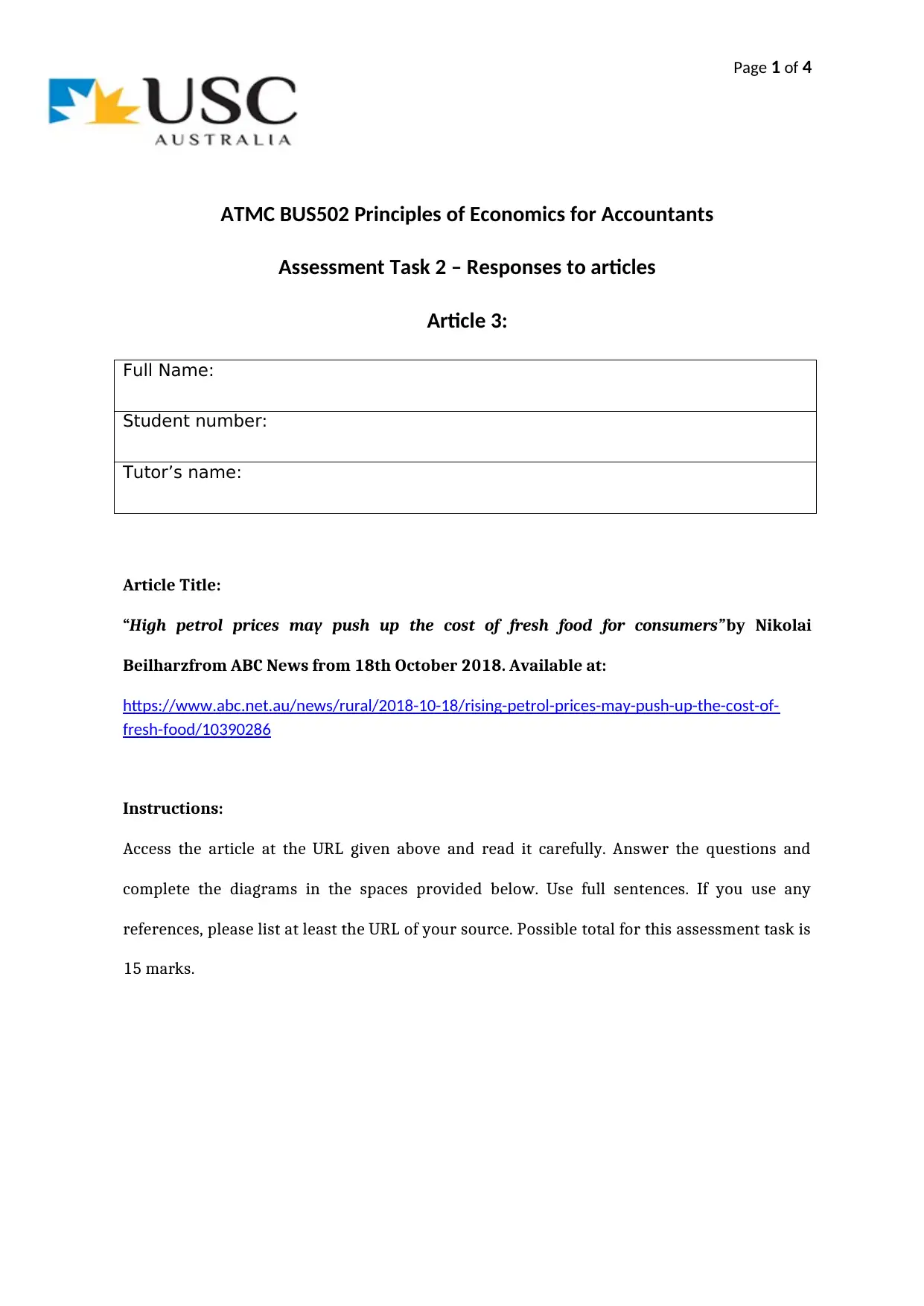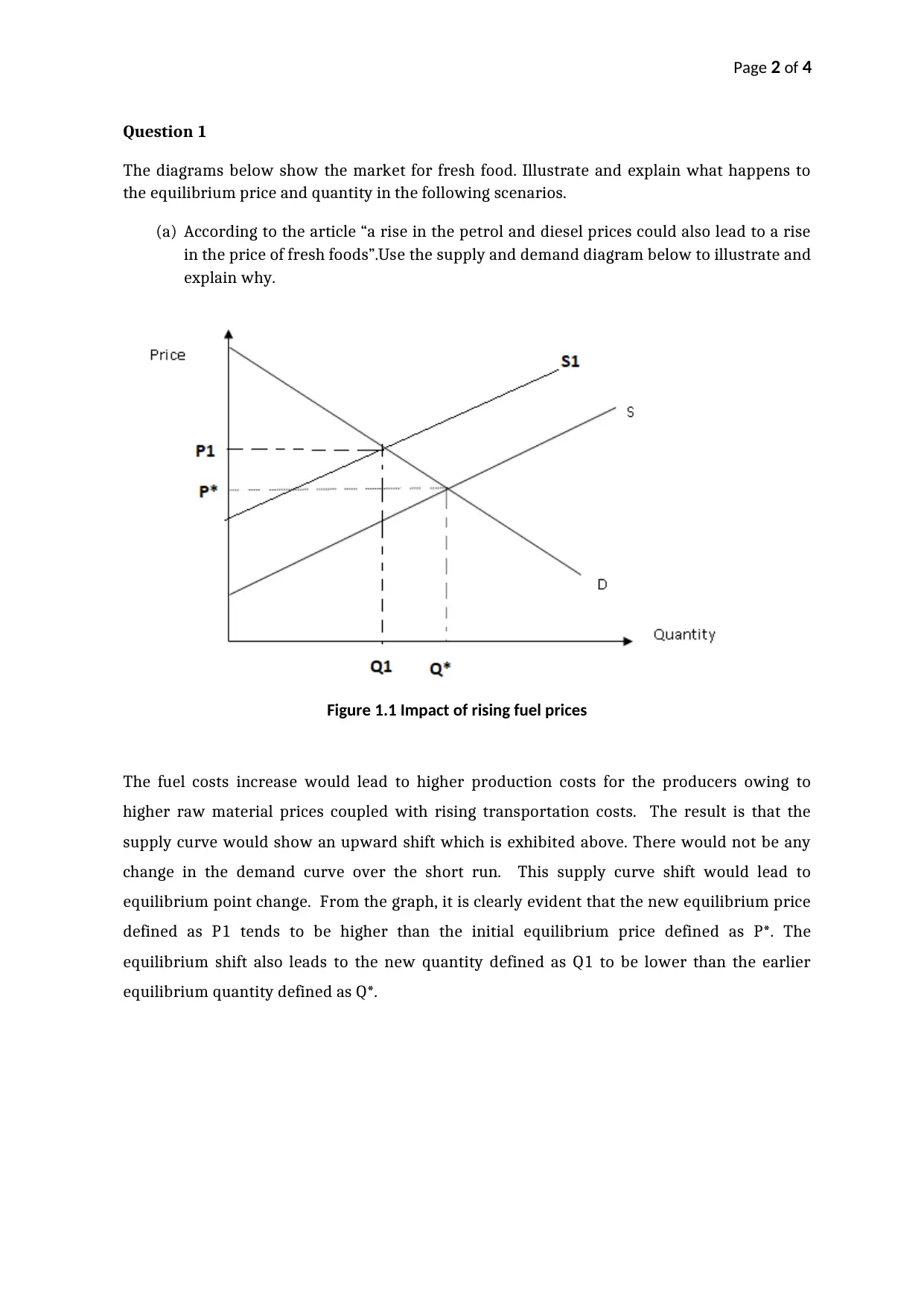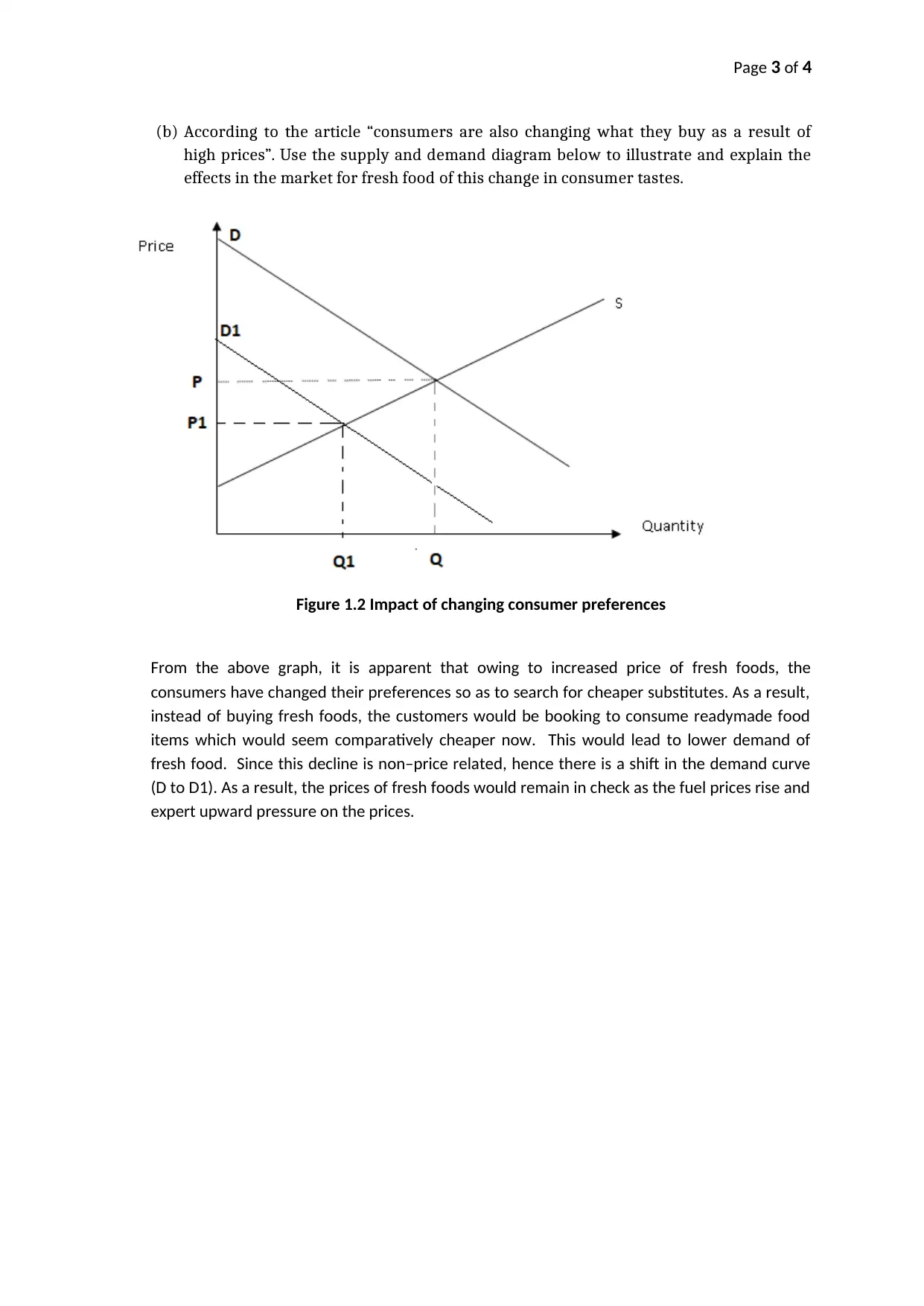ATMC BUS502 Principles of Economics for Accountants Assignment 2
VerifiedAdded on 2023/03/17
|4
|832
|50
Homework Assignment
AI Summary
This assignment analyzes the impact of rising petrol prices on the fresh food market, focusing on the principles of economics relevant to accountants. The student answers questions related to supply and demand diagrams, illustrating how increased fuel costs and changing consumer preferences aff...

Page 1 of 4
ATMC BUS502 Principles of Economics for Accountants
Assessment Task 2 – Responses to articles
Article 3:
Full Name:
Student number:
Tutor’s name:
Article Title:
“High petrol prices may push up the cost of fresh food for consumers”by Nikolai
Beilharzfrom ABC News from 18th October 2018. Available at:
https://www.abc.net.au/news/rural/2018-10-18/rising-petrol-prices-may-push-up-the-cost-of-
fresh-food/10390286
Instructions:
Access the article at the URL given above and read it carefully. Answer the questions and
complete the diagrams in the spaces provided below. Use full sentences. If you use any
references, please list at least the URL of your source. Possible total for this assessment task is
15 marks.
ATMC BUS502 Principles of Economics for Accountants
Assessment Task 2 – Responses to articles
Article 3:
Full Name:
Student number:
Tutor’s name:
Article Title:
“High petrol prices may push up the cost of fresh food for consumers”by Nikolai
Beilharzfrom ABC News from 18th October 2018. Available at:
https://www.abc.net.au/news/rural/2018-10-18/rising-petrol-prices-may-push-up-the-cost-of-
fresh-food/10390286
Instructions:
Access the article at the URL given above and read it carefully. Answer the questions and
complete the diagrams in the spaces provided below. Use full sentences. If you use any
references, please list at least the URL of your source. Possible total for this assessment task is
15 marks.
Paraphrase This Document
Need a fresh take? Get an instant paraphrase of this document with our AI Paraphraser

Page 2 of 4
Question 1
The diagrams below show the market for fresh food. Illustrate and explain what happens to
the equilibrium price and quantity in the following scenarios.
(a) According to the article “a rise in the petrol and diesel prices could also lead to a rise
in the price of fresh foods”.Use the supply and demand diagram below to illustrate and
explain why.
Figure 1.1 Impact of rising fuel prices
The fuel costs increase would lead to higher production costs for the producers owing to
higher raw material prices coupled with rising transportation costs. The result is that the
supply curve would show an upward shift which is exhibited above. There would not be any
change in the demand curve over the short run. This supply curve shift would lead to
equilibrium point change. From the graph, it is clearly evident that the new equilibrium price
defined as P1 tends to be higher than the initial equilibrium price defined as P*. The
equilibrium shift also leads to the new quantity defined as Q1 to be lower than the earlier
equilibrium quantity defined as Q*.
Question 1
The diagrams below show the market for fresh food. Illustrate and explain what happens to
the equilibrium price and quantity in the following scenarios.
(a) According to the article “a rise in the petrol and diesel prices could also lead to a rise
in the price of fresh foods”.Use the supply and demand diagram below to illustrate and
explain why.
Figure 1.1 Impact of rising fuel prices
The fuel costs increase would lead to higher production costs for the producers owing to
higher raw material prices coupled with rising transportation costs. The result is that the
supply curve would show an upward shift which is exhibited above. There would not be any
change in the demand curve over the short run. This supply curve shift would lead to
equilibrium point change. From the graph, it is clearly evident that the new equilibrium price
defined as P1 tends to be higher than the initial equilibrium price defined as P*. The
equilibrium shift also leads to the new quantity defined as Q1 to be lower than the earlier
equilibrium quantity defined as Q*.

Page 3 of 4
(b) According to the article “consumers are also changing what they buy as a result of
high prices”. Use the supply and demand diagram below to illustrate and explain the
effects in the market for fresh food of this change in consumer tastes.
Figure 1.2 Impact of changing consumer preferences
From the above graph, it is apparent that owing to increased price of fresh foods, the
consumers have changed their preferences so as to search for cheaper substitutes. As a result,
instead of buying fresh foods, the customers would be booking to consume readymade food
items which would seem comparatively cheaper now. This would lead to lower demand of
fresh food. Since this decline is non–price related, hence there is a shift in the demand curve
(D to D1). As a result, the prices of fresh foods would remain in check as the fuel prices rise and
expert upward pressure on the prices.
(b) According to the article “consumers are also changing what they buy as a result of
high prices”. Use the supply and demand diagram below to illustrate and explain the
effects in the market for fresh food of this change in consumer tastes.
Figure 1.2 Impact of changing consumer preferences
From the above graph, it is apparent that owing to increased price of fresh foods, the
consumers have changed their preferences so as to search for cheaper substitutes. As a result,
instead of buying fresh foods, the customers would be booking to consume readymade food
items which would seem comparatively cheaper now. This would lead to lower demand of
fresh food. Since this decline is non–price related, hence there is a shift in the demand curve
(D to D1). As a result, the prices of fresh foods would remain in check as the fuel prices rise and
expert upward pressure on the prices.
⊘ This is a preview!⊘
Do you want full access?
Subscribe today to unlock all pages.

Trusted by 1+ million students worldwide

Page 4 of 4
Question 2
The article stated that “farmers often say they are price takers.” Explain what this concept
means in term of market structure and analyse at least other three characteristics of this type
of market.
The farmers are price takers implies that any economic decision on their part i.e. to alter the
price or supply would not change the price. The prices are essentially driven by the supply and
demand sources at the industry level. At the individual level, any particular seller does not
have any significant market share so as to able to alter the market dynamics along. This is a
typical feature of perfectly competitive markets. Other key characteristics associated with this
particular market structure are listed below.
1) There is no differentiation with regards to product or price.
2) The market tends to be highly fragmented and no particular seller has any significant
market share owing to which pricing power is absent.
3) There is absence of any exit or entry barriers for the market participants.
Question 3
According to the article consumers “instead of buying a t-bone steak they might buy sausages”.
Explain in your own words what this means in terms of the cross-price elasticity of demand.
The cross price elasticity in terms of demand indicates the change in quantity demanded of a
given product when there is alteration in the price of another product. Based on whether
cross price elasticity is positive or negative, it can be inferred if the given pair of products
would be called as substitutes or complements. For complementary products, increase in the
price of one product would lead to reduction in demand for the other product. For substitute
products, increase in the price of one product would lead to increase in demand for the other
product.
Question 2
The article stated that “farmers often say they are price takers.” Explain what this concept
means in term of market structure and analyse at least other three characteristics of this type
of market.
The farmers are price takers implies that any economic decision on their part i.e. to alter the
price or supply would not change the price. The prices are essentially driven by the supply and
demand sources at the industry level. At the individual level, any particular seller does not
have any significant market share so as to able to alter the market dynamics along. This is a
typical feature of perfectly competitive markets. Other key characteristics associated with this
particular market structure are listed below.
1) There is no differentiation with regards to product or price.
2) The market tends to be highly fragmented and no particular seller has any significant
market share owing to which pricing power is absent.
3) There is absence of any exit or entry barriers for the market participants.
Question 3
According to the article consumers “instead of buying a t-bone steak they might buy sausages”.
Explain in your own words what this means in terms of the cross-price elasticity of demand.
The cross price elasticity in terms of demand indicates the change in quantity demanded of a
given product when there is alteration in the price of another product. Based on whether
cross price elasticity is positive or negative, it can be inferred if the given pair of products
would be called as substitutes or complements. For complementary products, increase in the
price of one product would lead to reduction in demand for the other product. For substitute
products, increase in the price of one product would lead to increase in demand for the other
product.
1 out of 4
Related Documents
Your All-in-One AI-Powered Toolkit for Academic Success.
+13062052269
info@desklib.com
Available 24*7 on WhatsApp / Email
![[object Object]](/_next/static/media/star-bottom.7253800d.svg)
Unlock your academic potential
© 2024 | Zucol Services PVT LTD | All rights reserved.





